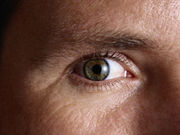Risk of collision highest from pedestrians at angle of 45 degrees from patient with retinitis pigmentosa
THURSDAY, Dec. 22, 2016 (HealthDay News) — For patients with retinitis pigmentosa, the risk of collision is highest from pedestrians at an angle of 45 degrees from the patient’s walking path, according to a study published in the December issue of the Journal of Vision.
Noting that prisms can create artificial peripheral islands of vision, Eli Peli, O.D., from the Schepens Eye Research Institute at Harvard Medical School in Boston, and colleagues examined the visual angle at which these islands can be most effective for preventing pedestrian collisions. They modeled the collision risk density as a function of bearing angle of pedestrians relative to the patient. They assumed pedestrians at all possible locations were moving in all directions with equal probability.
The researchers found that the risk density was highly anisotropic, and peaked at about 45 degrees eccentricity. The risk shifted to higher eccentricities with increasing pedestrian speed. The risk density was found not to be dependent on time to collision. On comparison of the model results with the binocular residual peripheral island locations of 42 patients with retinitis pigmentosa, the prevalence of natural residual islands peaked nasally at about 45 degrees, but temporally at about 75 degrees. As a result of this asymmetry, the binocular field of view had complementary coverage. There was good matching for natural residual binocular island eccentricities and the collision-risk density function, with optimization of detection of other walking pedestrians and other hazards.
“Field expansion prism devices will be most effective if they can create artificial peripheral islands at about 45 degree eccentricities,” the authors write. “The collision risk and residual island findings raise interesting questions about normal visual development.”
One author has a patent application for the prism that is the motivation for the work.
Full Text
Copyright © 2016 HealthDay. All rights reserved.








